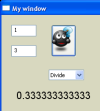Parser should skip the comments.
I did a test in BeautifulSoup(3.08) dont use newer version.
xml = """
<Label> Hello!</Label>
<!-- The above label says Hello.
-- It is clear, no? Let's try spicing it up a bit.
-- Add some color to it.
-->
<Label color="#FF0000">HI I'M RED-Y.</Label>
"""
from BeautifulSoup import BeautifulSoup
soup = BeautifulSoup(xml)
matches = soup.findAll('label')
for i,match in enumerate(matches):
print i, match.text
'''Out-->
0 Hello!
1 HI I'M RED-Y.
'''